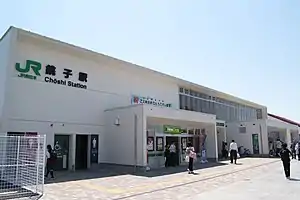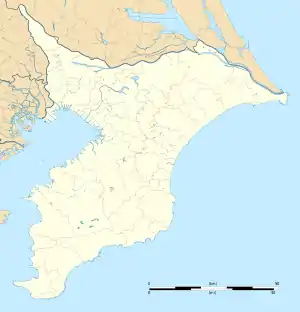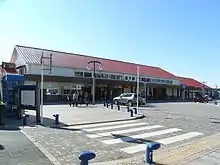Chōshi Station
Chōshi Station (銚子駅, Chōshi-eki) is an interchange passenger railway station in the city of Chōshi, Chiba, Japan, operated by the East Japan Railway Company (JR East) and also used by the private railway operator Choshi Electric Railway.
Chōshi Station 銚子駅 | |
|---|---|
 Chōshi Station exterior in May 2018 | |
| Location | Nishi-shibachō, Chōshi-shi, Chiba-ken 288-0044 Japan |
| Coordinates | 35°43′45″N 140°49′39″E |
| Operated by |
|
| Line(s) |
|
| Distance | 120.5 km from Tokyo |
| Platforms | 1 side + 1 island + 1 bay platform |
| Connections | Bus terminal |
| Other information | |
| Station code | CD-01 |
| Website | Official website |
| History | |
| Opened | 1 June 1897 |
| Rebuilt | 1936, 1948, 2018 |
| Passengers | |
| 3045 daily (JR FY2019); 384 (Choshi Electric FY2018) | |
| Location | |
 Chōshi Station Location within Chiba Prefecture  Chōshi Station Chōshi Station (Japan) | |
Lines
Chōshi Station is the eastern terminal station of the Sōbu Main Line and serves some through trains on the Narita Line to Sawara and Narita. It is 120.5 km (74.9 mi) from the western terminus of the Sōbu Main Line at Tokyo Station. It also forms the terminus of the privately operated Chōshi Electric Railway Line to Tokawa.[1]
Station layout
The JR East station facilities consist of one side platform and one island platform serving three tracks. A bay platform is located between the JR platforms 2 and 3 for Choshi Electric Railway trains. The station has a "Midori no Madoguchi" staffed ticket office.[2]
 Platform 1 in May 2005
Platform 1 in May 2005 The Dutch-style shelter for the Chōshi Electric Railway Line platform in May 2005
The Dutch-style shelter for the Chōshi Electric Railway Line platform in May 2005 A Suica wicket for passengers transferring between JR East and the Choshi Electric Railway on platforms 2/3 in January 2012
A Suica wicket for passengers transferring between JR East and the Choshi Electric Railway on platforms 2/3 in January 2012 The west end of platforms 2/3 in January 2012
The west end of platforms 2/3 in January 2012
Platforms
| 1 | ■ Sōbu Main Line | for Yōkaichiba, Narutō, Chiba, and Tokyo |
| ■ Limited express Shiosai | for Yōkaichiba, Narutō, Chiba, and Tokyo | |
| ■ Limited express Ayame | for Sawara, Narita, Chiba, and Tokyo | |
| 2 | ■ Sōbu Main Line | for Asahi, Yōkaichiba, Narutō, and Chiba |
| - | ■ Chōshi Electric Railway Line | for Nakanochō, Inuboh, and Tokawa |
| 3 | ■ Narita Line | for Sawara, Narita, and Chiba |
Adjacent stations
| « | Service | » | ||
|---|---|---|---|---|
| Sōbu Main Line | ||||
| Iioka | Shiosai | Terminus | ||
| Matsugishi | Local | Terminus | ||
| Narita Line | ||||
| Shimōsa-Toyosato | Ayame | Terminus | ||
| Matsugishi | Local | Terminus | ||
| Chōshi Electric Railway Line | ||||
| Terminus | - | Nakanochō | ||
History

Chōshi Station opened on 1 June 1897 as a station on the Sōbu Railway.[2] On 1 September 1907, the Sōbu Railway was nationalized, becoming part of the Japanese Government Railway (JGR).
The Chōshi Electric Railway Line from Choshi to Tokawa opened on 5 July 1923, using the trackbed and infrastructure of the earlier Chōshi Sightseeing Railway (銚子遊覧鉄道, Chōshi Yūran Tetsudō), which operated between Chōshi and Inuboh from December 1913 to November 1917.[3] The original station building was replaced by a new two-storey wood-frame-and-mortar building in 1936. An additional platform was added at the same time, and a new underground passage was opened linking the new platform. The 1936 station building lasted only nine years, as it was destroyed in 1945 by fire during World War II. The third-generation station building was completed in January 1948, and a further platform was added at the same time, creating the three-platform arrangement that continues to this day.[4]
After World War II, JGR became the Japanese National Railways (JNR). Scheduled freight operations were suspended from 31 March 1978. The station was absorbed into the JR East network upon the privatization of JNR on 1 April 1987.
A roof was added to the entrance to the Choshi Electric Railway platform in December 1974, and this was replaced by the present-day Dutch-style building in November 1990.[4]
Passenger statistics
In fiscal 2019, the JR portion of the station was used by an average of 3045 passengers daily (boarding passengers only).[5]In fiscal 2018, the Choshi Electric Railway station was used by an average of 384 passengers daily (boarding passengers only).[6]The passenger figures for previous years are as shown below.
| Fiscal year | Daily average | |
|---|---|---|
| JR East | Choshi Electric Railway | |
| 2000 | 4,174[7] | |
| 2001 | 4,055[8] | |
| 2002 | 3,868[9] | |
| 2003 | 3,768[10] | |
| 2004 | 3,743[11] | |
| 2005 | 3,693[12] | |
| 2006 | 3,605[13] | |
| 2007 | 3,481[14] | 935[15] |
| 2008 | 3,324[16] | 889[17] |
| 2009 | 3,249[18] | 795[19] |
| 2010 | 3,352[20] | 673[21] |
| 2011 | 3,366[22] | |
| 2012 | 3,395[23] | |
Surrounding area
- Chōshi City Office
- Chiba Institute of Science
- Yamasa head office and soy sauce factory
- Higeta soy sauce factory
- Choshi Camera Museum[24]
- Futaba Elementary School
- Tone River
 National Route 124
National Route 124 National Route 356
National Route 356
Bus terminal
The following long-distance buses operate from Choshi Station.
| Busstop | No | Via | destination | Company | Note |
|---|---|---|---|---|---|
| 1 | Kasugadai Line(circular-route bus) | Shiritsu-Kōkō mae→Kasugadai→Misaki | Choshi Station | Keisei Taxi Narita | Runs only in the morning |
| Misaki→Kasugadai→Shiritsu-Kōkō mae→Kasugadai | Runs only in the evening | ||||
| 2 | Asahi-Choshi Line | Misaki・Aeon Choshi・Tasaki-Jinja・Īoka Shisyo(Īoka beach・Hagizono beach) | Asahi Station (Chiba) | Chiba Kōtsū | |
| Aeon Shuttle Line | Non stop | Aeon Mall Choshi | |||
| Toyosato Newtown Line | Matsugishi Station・Shiishiba Station・Shimosa-Toyosato Station | Toyosato Newtown No.4 | |||
| 3 | Express bus Inuboh(Expressway bus) | Asahi-chuo Hospital Higashi | Tokyo Station | Keisei Bus・Chiba Kōtsū | Asahi route |
| Express bus Tone Liner(Expressway bus)[25] | Shisui Premium Outlets | Chiba Kōtsū | Omigawa・Sawara route | ||
| 4 | Kawaguchi Line | Choshi-kannon・Kawaguchi | Choshi-port Center | Keisei Taxi Narita | |
| Misaki-meguri Shuttle | Port Tower Wosse・Ashikajima Station・Kimigahama Station・Inubosaki Lighthouse・Inuboh Station | Chikyū Tembōkan | Chiba Kōtsu | ||
| 5 | Southern Cross(Night bus) | Kyoto Station・Osaka Station・Namba Station | USJ | Chiba Kōtsu・Nankai Bus | |
| Nagasaki Line | Choshi-ginza・Nagasaki | Kokumin-syukusya(Hotel) | Chiba Kōtsu | ||
| Naarai Line | Naarai・Choshi Marina(Byobugaura) | Chiba Kagaku Daigaku | |||
| 6 | Ashikajima Line(circular-route bus) | Kasagami-Kurohae Station→Ashikajima Station | Choshi Station | Keisei Taxi Narita | Runs only in the morning |
| Ashikajima Station→Kasagami-Kurohae Station | Runs only in the evening | ||||
| Tokawa Line | Inuboh Station | Togawa Shako(Tokawa Station) | |||
| 7 | Tonegawa Line | Hasaki | Kashima-Jingū Station | Kanto Railway | Change the Hasaki Expressway bus which bound for Tokyo at Hasaki Busstop. |
| Kaigan Line | Hasaki・Hasaki chuo | Hasaki Kaisuiyokuzyō |
See also
References
- Terada, Hirokazu (19 January 2013). データブック日本の私鉄 [Databook: Japan's Private Railways]. Japan: Neko Publishing. p. 41. ISBN 978-4-7770-1336-4.
- 各駅情報(銚子駅) [Station Information: Chōshi Station] (in Japanese). Japan: East Japan Railway Company. Retrieved 19 January 2012.
- Shirato, Sadao (March 2014). 銚子遊覧鉄道 [Chōshi Sightseeing Railway]. The Railway Pictorial (in Japanese). Japan: Denkisha Kenkyūkai. 64 (887): 108–109.
- Shirato, Sadao (June 2011). 銚子電気鉄道(上) [Choshi Electric Railway Volume One]. Japan: Neko Publishing Co., Ltd. pp. 22–23. ISBN 978-4-7770-5309-4.
- 各駅の乗車人員 (2019年度) [Station passenger figures (Fiscal 2019)] (in Japanese). Japan: East Japan Railway Company. 2020. Retrieved 11 August 2020.
- 千葉県統計年鑑(平成19年 [Chiba Prefecture Statistics (Fiscal 2006)] (in Japanese). Japan: Chiba Prefecture. 2007. Retrieved 11 August 2020.
- 各駅の乗車人員 (2000年度) [Station passenger figures (Fiscal 2000)] (in Japanese). Japan: East Japan Railway Company. Retrieved 22 December 2011.
- 各駅の乗車人員 (2001年度) [Station passenger figures (Fiscal 2001)] (in Japanese). Japan: East Japan Railway Company. Retrieved 22 December 2011.
- 各駅の乗車人員 (2002年度) [Station passenger figures (Fiscal 2002)] (in Japanese). Japan: East Japan Railway Company. Retrieved 22 December 2011.
- 各駅の乗車人員 (2003年度) [Station passenger figures (Fiscal 2003)] (in Japanese). Japan: East Japan Railway Company. Retrieved 22 December 2011.
- 各駅の乗車人員 (2004年度) [Station passenger figures (Fiscal 2004)] (in Japanese). Japan: East Japan Railway Company. Retrieved 22 December 2011.
- 各駅の乗車人員 (2005年度) [Station passenger figures (Fiscal 2005)] (in Japanese). Japan: East Japan Railway Company. Retrieved 22 December 2011.
- 各駅の乗車人員 (2006年度) [Station passenger figures (Fiscal 2006)] (in Japanese). Japan: East Japan Railway Company. Retrieved 22 December 2011.
- 各駅の乗車人員 (2007年度) [Station passenger figures (Fiscal 2007)] (in Japanese). Japan: East Japan Railway Company. Retrieved 22 December 2011.
- 民鉄等駅別1日平均運輸状況 2007(平成19)年度 [Private railway average daily passenger figures by station (Fiscal 2008)] (Excel) (in Japanese). Japan: Chiba Prefectural Government. 2011. Retrieved 2 June 2014.
- 各駅の乗車人員 (2008年度) [Station passenger figures (Fiscal 2008)] (in Japanese). Japan: East Japan Railway Company. Retrieved 22 December 2011.
- 民鉄等駅別1日平均運輸状況 2008(平成20)年度 [Private railway average daily passenger figures by station (Fiscal 2008)] (Excel) (in Japanese). Japan: Chiba Prefectural Government. 2011. Retrieved 2 June 2014.
- 各駅の乗車人員 (2009年度) [Station passenger figures (Fiscal 2009)] (in Japanese). Japan: East Japan Railway Company. Retrieved 22 December 2011.
- 民鉄等駅別1日平均運輸状況 2009(平成21)年度 [Private railway average daily passenger figures by station (Fiscal 2009)] (Excel) (in Japanese). Japan: Chiba Prefectural Government. 2011. Retrieved 2 June 2014.
- 各駅の乗車人員 (2010年度) [Station passenger figures (Fiscal 2010)] (in Japanese). Japan: East Japan Railway Company. Retrieved 4 July 2012.
- 民鉄等駅別1日平均運輸状況 2010(平成22)年度 [Private railway average daily passenger figures by station (Fiscal 2010)] (Excel) (in Japanese). Japan: Chiba Prefectural Government. 2011. Retrieved 2 June 2014.
- 各駅の乗車人員 (2011年度) [Station passenger figures (Fiscal 2011)] (in Japanese). Japan: East Japan Railway Company. Retrieved 4 July 2012.
- 各駅の乗車人員 (2012年度) [Station passenger figures (Fiscal 2012)] (in Japanese). Japan: East Japan Railway Company. Retrieved 28 July 2013.
- Choshi Camera Museum official website Archived 10 December 2013 at the Wayback Machine Retrieved 28 January 2012. (in Japanese)
- "銚子~東京駅". www.keiseibus.co.jp. Retrieved 17 October 2020.
-
- This is cheaper than the Tone Liner (For Tokyo) and the Inuboh Liner(For Tokyo), these fare for 2600yen(adult).
- And this fare for from Choshi Station to Hasaki is 210yen(adult) and from Hasaki to Tokyo is 2150yen(adult), these add up to 2360yen(adult)
- Hasaki Liner
- JRbus kanto